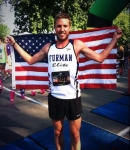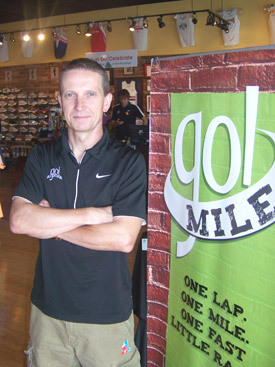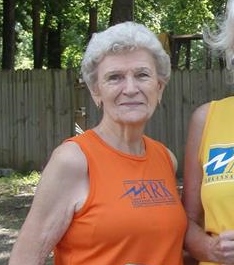The ultimate race?

For record setters, the Mile outpaces all other competitors
By Frank Fellone, Arkansas Democrat-Gazette
Jose Castelano was flying along, looking cool in shades and an Oregon shirt, spectators cheering for him and the rest of the elite runners on the course near the soccer fields at Burns Park in North Little Rock.
At 5:05.91, he sped across the finish line. Not bad for 15-years-old. Not bad for a sophomore on the track team at Dardanelle High School.
Not bad for a Mile.
A Mile. Not 1600 meters, the standard in Arkansas high schools now. Not 1500 meters, which Olympians have run since 1896.
A Mile. In other words, 5280 feet, or 1760 yards, or 1,000 Roman paces, or 1609 and 34 hundredths meters.
Castelano’s speedy Mile came at the Go! Mile on June 14, where about 600 runners zipped through seven heats based on age, sex and speed. It was the fourth Go! Mile, race director Gary Taylor said (below). The first drew about 350 runners.
 “It’s really for everyone,” Taylor said, including his 83-year-old father-in-law, for whom walking that Mile “is a big deal.”
“It’s really for everyone,” Taylor said, including his 83-year-old father-in-law, for whom walking that Mile “is a big deal.”
Setting a record in the Mile used to be a big deal. Not so much anymore, having been surpassed in publicity and practice by the 5K, the 10K and especially the marathon.
Still, Taylor said, “The Mile is the ultimate test of speed.”
He would know. The former University of Arkansas at Fayetteville track star ran the Mile in 3:57 in 1988 at a meet in Ireland. His son, Brendan, a recent graduate of Little Rock Catholic High School for Boys, has run a Mile in 4:13. Brendan will run track soon at the University of Oklahoma. Another son and CHS student, Kieran, recently won the 800 meter race in 1:57 at the state Meet of Champions.
MILESTONES
2014 is the anniversary, in round numbers of 60 and 50, of two famous Mile runs. In 1954, Britain’s Roger Bannister ran the first sub-4:00 Mile. And in 1964, Jim Ryun of East High School in Wichita, Kan., became the first high-schooler to break 4 minutes when he ran 3:59 at a meet in Compton, Calif. — and finished eighth against a world class field.
The current record holder is Hicham El Guerrouj of Morocco. He ran a 3:43.13 in 1999.
Bannister’s Mile record, justly celebrated, lasted for only two months. On June 21, Australia’s John Landy finished in 3:58, and a golden age of the Mile was on, an era populated with great Milers — Peter Snell, Ryun, Marty Liquori, John Walker, Sebastian Coe, Steve Ovett, Steve Scott and Steve Cram.
Ryun was a superstar in his prime, appearing on the cover of Sports Illustrated seven times.
After which the United States went metric at the high-school level, and the mystique of the Mile became the mystique of the 1600 meters.
Except there is no such 1600-meter mystique, Ryan Lamppa says.
“No American boy ever dreamed of breaking 4 minutes over 1600 meters,” he said from Santa Barbara, Calif.
Consider Bannister.
“The fact is that moment still resonates 60 years later. Four minutes — that benchmark has carried over.”
Lamppa speaks for the Mile as founder of Bring Back the Mile, an organization whose goal is to promote the Mile and specifically to bring it back to American high schools.
Where did the Mile go, and when?
Track, and tracks, transitioned in the late 1970s and 1980s, Lamppa said, distances going from imperial to metric.
“They fumbled the ball,” he said of high school athletic federations. Rather than keeping the Mile, the vast majority of states went not to 1500 meters — the Olympic measure — “because Americans don’t get it,” but to the 1600, “which was close enough” in spite of the fact there was no history of the 1600 in the United States.
Kathy and Charles Tadlock of Sheridan agree on the timing. She worked for the Arkansas Activities Association for 30 years, retiring in 2010, and recalls the change from imperial to metric measurements in the 1980s. The whole country was changing to metric, she said, including high school sports federations: “We weren’t the first, and probably weren’t the last.”
Charles Tadlock coached high school sports for 20 years at Charleston and Sheridan. He was coaching at the latter around 1980 when a new track was built. It was, of course, metric.
“All the new tracks at that time were being built to the new metric specifications.”
Bring back the Mile?
“I know that’s popular with some coaches,” Kathy Tadlock said. But not necessarily among the kids. “We’re talking about people in a different age range.”
It would be tough to bring back the Mile, Charles Tadlock said. Besides, he said, “people now refer to the 1600 as the Mile.”
Lamppa agreed that some of the luster of the Mile has gone away. Other distances, especially the marathon, pique the public interest.
“The Mile isn’t as prominent as it once was,” he said, “but it’s not going away. There’s not a Roger Bannister moment for those other events. The Mile is a brand.”
Massachusetts high schools still run Mile- and 2-Mile contests, Lamppa said. He’s looking for a beachhead, another state federation that would bring back the Mile.
After which another and another.
“We want the Mile back in Arkansas and Minnesota and other states. The fact is the Mile is understandable and relatable, and our country has the best Milers in the world, both genders, better than Kenya.”
PRO-MILER
A beachhead exists in Arkansas. It’s Lake Hamilton High School, where the track team is coached by Mile enthusiast Karl Koonce. Koonce has coached track for 41 years, 33 of those at Lake Hamilton. “I’m gonna stick with it,” he said.
He’s also a member of Bring Back the Mile.
“We’re very much into bringing back the Mile at Lake Hamilton High School,” Koonce said. “The main reason is that most people call the 1600 the Mile. I’m constantly telling them, no, it’s not. We educate our kids on the difference. If you run a 3:59.9 in the 1600, it’s not a sub-4:00 Mile. It’s a sub-4:00 1600. It’s not the same.”
The Mile lives on at the NCAA level at indoor meets, Koonce said, but outdoor meets run the 1500.
Don’t get Koonce started on the 1500. “It’s the most ridiculous distance. It’s three and three-quarters laps. I don’t get it myself.”
The only place the 1600 is contested in high schools is the United States, Koonce said. “It goes back to the 1980s when tracks turned metric. The 1600 made more sense than the 1500. The 1600 is still a four-lap race.”
“I’m old-school, I guess,” Koonce added. “Let’s back up 9.3 meters and run the Mile. I think it’s a movement. We want to literally reinstate the Mile for high schools. Do away with the 1600 and bring back the Mile.”
Old-school, indeed. Koonce was a runner in the first Mile race in Arkansas in which the 4-minute barrier was broken. It was in the National Association of Intercollegiate Athletics national championship meet on May 25, 1973, held at Henderson State University in Arkadelphia, where Koonce ran track.
Koonce ran his fastest Mile that day, “4:08 flat” — and finished eighth.
The winner was Tommy Fulton of Texas Southern University, who crossed the finish line in 3:57.8. Second was Bob Maplestone of Eastern Washington University. He finished at 3:58.5.
“I knew I wasn’t under 4 minutes,” Koonce said, “but that was a little bit surprising.”
Koonce still runs with his students and to stay fit. How fast could he run the Mile today?
“I might could run it in 5:15. Might kill me.”
ROAD RUNNERS
 Karl Koonce, meet Frances Barger of North Little Rock (left). She is 80-years-old. She ran the Go! Mile in 10:43.30, after which she posed with friends for a photo.
Karl Koonce, meet Frances Barger of North Little Rock (left). She is 80-years-old. She ran the Go! Mile in 10:43.30, after which she posed with friends for a photo.
Those friends were Patti Hammerstein, 54, of Sherwood, 8:52.40; Kathleen Rea, 54, of North Little Rock, 6:40.30; Debbie Strobel, 58, of North Little Rock, 8:35.04, and Angie Orellano-Fisher, 65, of Sherwood, 7:52.81.
Since 2012, Barger has held the state Mile record for women ages 75-79 — 10:18.28, also set at the Go! Mile. Now, says Randy Taylor, who represents Arkansas on the USA Track & Field Long Distance Running Committee, she holds the state age-group record for the Mile for women age 80 and older.
And she wasn’t the only star at the recent Go! Mile. The first finisher, 24-year-old Michael Hammond of Greenville, S.C., set a new overall Mile record for the state: 4:07.54. And the first woman to finish, 23-year-old Keri McClary of Springdale, set an overall fastest woman’s road Mile record: 4:52.51.
“There were a total of eight new men’s records and eight new women’s records set this year, including both overall records,” Taylor said, noting that all the state road Mile records have been set at the Go! Mile because it’s the only certified Mile race in the state. “It’s only been certified for four years, so these records are only 4 years old,” Taylor added. “We just compiled them last year because of the popularity of the Mile.”
Why so popular?
“The challenge of the Mile is that it’s a fast sprint,” Orellano-Fisher said after the recent Go! Mile. “It’s a gut check at the beginning and all the way to the finish.” She was happy with her time, she said, given she hadn’t been doing much speed work.
Orellano-Fisher started running at 40: “I had never run in my life. I started out running from one light post to the next.”
Lynne Phillips, 45, of Little Rock said the Mile is simply fun. She ran hers in 8:30, four seconds lower than last year. “I’m not very serious about it,” she said.
Liston Barber, 20, ran his Mile in 5:37.25, and gave credit to his ROTC runs at UA, the ones with a 45-pound pack.
“Liston decided to run with the old ladies one morning and left us in the dust,” his mother, Laurie Phillips of Little Rock, said. Her Mile was her first since high school, accomplished in “9 something.”
“Yes, it was tough,” Laurie Phillips said. “You go faster for a shorter period of time — and people were passing me on both sides.”
Catching his breath nearby was Castelano, the speedy sophomore from Dardanelle. How did he train for his Mile? “Basically, I do quarters on a track, to build endurance for a longer run.” His approach to running, he said, is to run for a reason. His reason? “I love the sport. I do it for the challenge.”
